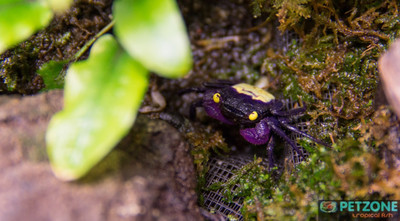Purple Vampire Crab
Posted by Max Gandara on on 19th Mar 2025
Purple Vampire Crab
The Purple Vampire Crab is one of nature's most fascinating and mysterious creatures. Known for its vibrant coloration and unique habitat, this species captures the imagination of aquarists and wildlife enthusiasts alike. In this blog, we will delve into the intriguing world of the Purple Vampire Crab, exploring its characteristics, habitat, care requirements, and more.
Introduction to the Purple Vampire Crab
The Purple Vampire Crab, scientifically known as Geosesarma dennerle, is a small, terrestrial crab species native to the lush forests of Southeast Asia. Despite its fierce-sounding name, this creature is not dangerous to humans. Instead, its name is inspired by its striking appearance, featuring a deep purple hue and bright yellow eyes reminiscent of a vampire from folklore.
Appearance and Characteristics
The Purple Vampire Crab is a sight to behold. Its body is adorned with a vibrant purple exoskeleton that provides excellent camouflage against the forest floor. The crab's bright yellow eyes, set against its dark body, give it an otherworldly appearance. Measuring about 1 to 2 inches across, this small crustacean boasts an impressive visual appeal that makes it a popular choice for vivarium enthusiasts.
Key Features:
-
Color: Deep purple with bright yellow eyes
-
Size: Approximately 1 to 2 inches in width
-
Lifespan: Can live up to 2 to 3 years in captivity with proper care
Natural Habitat
In the wild, Purple Vampire Crabs are found in the warm, humid environments of Southeast Asia's tropical rainforests. They thrive in areas with abundant leaf litter and hiding spots, which provide both shelter and hunting grounds. These crabs are primarily terrestrial but require access to freshwater sources, such as streams or puddles, to maintain their hydration and health.
Caring for the Purple Vampire Crab in Captivity
Owning a Purple Vampire Crab can be a rewarding experience for those willing to meet its unique care requirements. Here are some essential tips for creating a suitable habitat:
Setting Up the Tank
-
Size: A tank of at least 10 gallons is recommended for a small group of crabs.
-
Substrate: Use a mixture of soil, sand, and moss to mimic their natural environment.
-
Humidity: Maintain humidity levels between 75% and 85% using a misting system or regular spraying.
-
Temperature: Keep the temperature between 75°F and 82°F to ensure their comfort and health.
-
Water Source: Provide a shallow dish of dechlorinated water for hydration.
Diet and Feeding
Purple Vampire Crabs are omnivores and enjoy a varied diet. In captivity, they can be fed a mix of fruits, vegetables, and protein sources such as fish flakes, shrimp pellets, and insect larvae. It's crucial to ensure the food is fresh and to remove any leftovers to prevent contamination and maintain a clean environment.
Conclusion
The Purple Vampire Crab is a captivating creature that can bring a touch of the exotic to any vivarium. With their stunning appearance and intriguing behavior, these crabs offer a unique opportunity to observe a piece of the rainforest ecosystem up close. By understanding their natural habitat and care needs, enthusiasts can create a thriving environment where these magnificent crabs can live happily and healthily. Whether you're a seasoned aquarist or a curious beginner, the Purple Vampire Crab promises to be a fascinating addition to your collection.

